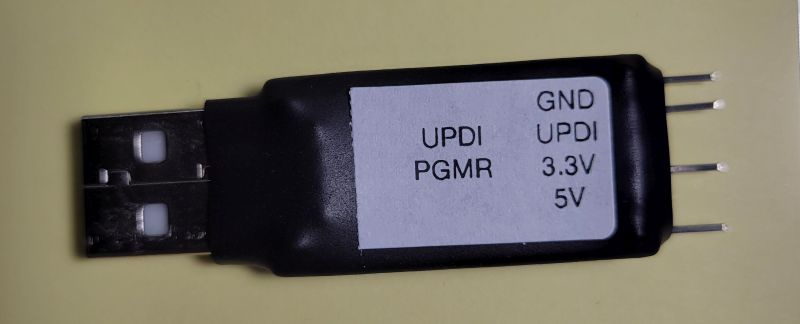only $5

What is it?
This is a programmer for your PC that supports the UPDI protocol.
It can be used to re-program the Uni-VFO kit, along with any other microcontroller that requires low-voltage UPDI progamming.
These are assembled here at the KitsAndParts headquarters, and fully tested before shipping.
This adapter uses the CH340 USB to TTL chipset. Linux systems will likely already have a driver installed.
Microsoft Windows systems will likely need the driver installed (just once).
You can download the driver directly from Nanjing Qinheng Microelectronics (the manufacturer of the chip)
Link: CH340 Drivers
The Arduino environment supports this programmer, along with the MegaTinyCore, to program the ATTiny microcontrollers.
It is also supported by AVRDUDE and AVRDUDESS (both available on github.com).
To reprogram the Uni-VFO kit:
Connect the ground pin of the programmer to Gnd on the Uni-VFO. Connect the PWR pin (+5 Volts)
on the programmer to Vin on the Uni-VFO. Connect the UPDI pin on the programmer to the UPDI pin on the Uni-VFO.
That's it. Only three wires for programming.
To load the HEX file, I use AVRDUDE. I use version 7.3 and it works great.
Much older versions don't support the serial UPDI programmer. You can get AVRDUDE from github.
I put it in its own directory on my pc (I used C:\Users\Mikemo\avrdude). I also put the hex file to program
in the same directory. From a Command Prompt, change directory to where the AVRDUDE program is located.
This is the command I use to burn the HEX file univfo_102.hex:
avrdude.exe -c serialupdi -P com4 -p t3224 -U flash:w:univfo_102.hex
The "-c" defines which programmer to use. The "-P" tells it which COM port the programmer is located.
The "-p" tells it which kind of chip you are programming. The "-U" says we are writing flash,
and the file to write is "univfo_102.hex". If it works, you'll see something like this:
C:\Users\Mikemo\avrdude>avrdude.exe -c serialupdi -P com4 -p t3224 -U flash:w:univfo_102.hex
avrdude: AVR device initialized and ready to accept instructions
avrdude: device signature = 0x1e9528 (probably t3224)
avrdude: Note: flash memory has been specified, an erase cycle will be performed.
To disable this feature, specify the -D option.
avrdude: erasing chip
avrdude: processing -U flash:w:univfo_100.hex:i
avrdude: reading input file univfo_102.hex for flash
with 6936 bytes in 1 section within [0, 0x1b17]
using 55 pages and 104 pad bytes
avrdude: writing 6936 bytes flash ...
Writing | ################################################## | 100% 1.84 s
avrdude: 6936 bytes of flash written
avrdude: verifying flash memory against univfo_102.hex
Reading | ################################################## | 100% 1.07 s
avrdude: 6936 bytes of flash verified
avrdude done. Thank you.
After it is programmed, remove the wires to the programmer and connect the serial port for configuration.
| Toroids, Ferrites |